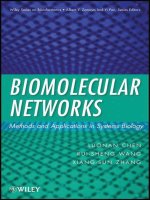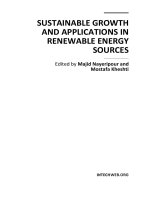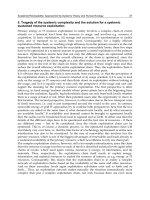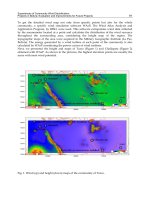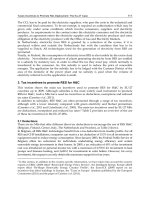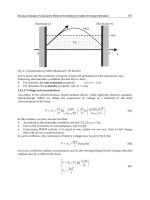Multiscale modeling and applications in nanotribology
Bạn đang xem bản rút gọn của tài liệu. Xem và tải ngay bản đầy đủ của tài liệu tại đây (6.02 MB, 220 trang )
MULTISCALE MODELING AND APPLICATIONS
IN NANOTRIBOLOGY
SU ZHOUCHENG
NATIONAL UNIVERSITY OF SINGAPORE
2012
MULTISCALE MODELING AND APPLICATIONS
IN NANOTRIBOLOGY
SU ZHOUCHENG
(M.ENG)
A THESIS SUBMITTED
FOR THE DEGREE OF DOCTOR OF PHILOSOPHY
DEPARTMENT OF MECHANICAL ENGINEERING
NATIONAL UNIVERSITY OF SINGAPORE
2012
Acknowledgement
i
Acknowledgement
The author would like to express his sincere gratitude to all of the kindhearted individuals
for their precious advice, guidance, encouragement and support, without which the
successful completion of this thesis would not have been possible.
Special thanks to the author’s supervisors Prof. Tay Tong-Earn and A/Prof. Vincent Tan
Beng Chye, whom the author has the utmost privilege and honor to work with. Their
instruction makes the exploration in multiscale modeling technique a wonderful journey.
Their profound knowledge on mechanics and strict attitude towards academic research
will benefit the author’s whole life.
The author would also like to thank Dr Zhang Bing, Dr Sun Xiushan, Dr Liu Guangyang,
Dr Yew Yong Kin, Dr Muhammad Ridha, Mr Chen Yu and Mr Mao Jiazhen for their
invaluable help. Many thanks to his friends Ms Li Sixuan, Dr Ren Yunxia, Mr Song
Shaoning, Mr Jiang Yong, and Mr Chen Boyang for making the research environment a
lively place.
Last but not least, the author expresses his utmost love and gratitude to his parents, wife,
sister and brother for their understanding and support during the course of this project.
Table of Contents
ii
Table of Contents
Acknowledgement i
Summary vi
Nomenclature ix
List of Figures xii
List of Tables xix
Chapter 1 Introduction and Literature Review 1
1.1 Introduction 1
1.2 Review of Multiscale Modeling Approaches 4
1.2.1 Quasi-continuum Method 4
1.2.2 Handshake Method 7
1.2.3 Bridging Scale Method 10
1.2.4 Coarse Grained Molecular Dynamics 13
1.2.5 Other Relevant Multiscale Modeling Techniques 14
1.3 Review of Studies on Nanotribology 16
1.4 Objectives and Significance of the Study 19
Chapter 2 Multiscale Modeling Using Pseudo Amorphous Cell 22
2.1 Conceptual Modeling of Pseudo Amorphous Cell 23
2.2 Formulation of PAC 27
2.2.1 Determination of
T
Matrix 28
2.2.2 Calculating Cell Stiffness Matrix of PAC for Pair-wise Potentials . 36
2.3 Coupling between Atomistic Region and PAC 42
2.4 Conclusion 48
Table of Contents
iii
Chapter 3 Computational Implementation 49
3.1 Multiscale and Molecular Simulator 50
3.1.1 PAC Implementation for Unit Cell 51
3.1.2 Solvers for Molecular Mechanics and Multiscale Simulations 53
3.2 Pre-processors 61
3.2.1 Polymer Modeling 62
3.2.2 Input Generator for Multiscale and Molecular Simulator 66
3.2.3 Indenter Generator for Multiscale and Molecular Simulator 68
3.3 Conclusion 69
Chapter 4 Validation of PAC Multiscale Modeling 71
4.1 Multiscale Simulation of Nanoindentation on a Polymer Substrate 71
4.2 Distinguishing Features of PAC-based Multiscale Modeling 76
4.2.1 Non-locality 77
4.2.2 Inhomogeneity 79
4.3 Conclusion 84
Chapter 5 Extension to Three Dimensional Modeling 85
5.1 Three Dimensional Multiscale Modeling 86
5.1.1 Determination of Transformation Matrix 86
5.1.2 Stiffness Calculations 93
5.2 Three Dimensional Multiscale Simulations of Nanoindentation 97
5.2.1 Nanoindentation on a Polymer Substrate 97
5.2.2 Nanoindentation on a Crystalline Substrate 104
5.3 Conclusion 108
Chapter 6 Extension to Complex Force Fields 109
6.1 Numerical Calculation of Hessian Matrix 110
6.2 Cell Stiffness Construction 111
Table of Contents
iv
6.3 Validations 120
6.3.1 Nanoindentation on a PE Substrate 121
6.3.2 Nanoindentation on a Silicon Substrate 125
6.4 Conclusion 129
Chapter 7 Multiscale Simulation of Nanoindentation on Thin-film / Substrate
System 130
7.1 Description of Models and Simulations 132
7.2 Simulation Results and Discussions 138
7.2.1 Analyses of Indentation Forces 138
7.2.1.1. Effect of Tip Rounding Radius 141
7.2.1.2. Effect of Included Angle 142
7.2.1.3. Effect of Interface Strength 143
7.2.1.4. Substrate Effects 144
7.2.2 Pile-up Effect 146
7.2.3 Atomic Interface Delamination 150
7.3 Conclusion 154
Chapter 8 Multiscale Simulation of Nanoscale Sliding 155
8.1 Sliding on 2D Crystalline Substrate 156
8.2 Sliding on 3D Polymer Substrate 158
8.2.1 Description of Models and Simulations 159
8.2.2 Results and Discussions 160
8.2.2.1 Penetration Depth and Mechanisms 161
8.2.2.2 Other Frictional Behaviors 165
8.3 Conclusion 168
Chapter 9 Conclusions and Recommendations 170
9.1 Conclusions 170
Table of Contents
v
9.2 Recommendations for Future Work 173
References 175
Appendix A Calculating the Stiffness Matrix of Pair-wise Potentials 191
Appendix B Strain Contour Calculation 197
Summary
vi
Summary
Recent advances in nanotechnology necessitate the development of multiscale modeling
techniques, which involve more than one length scale or time scale. In the past two
decades, various concurrent multiscale approaches have been developed to simulate
multiscale phenomena starting at nanoscale. However, most of existing multiscale
approaches are developed to model crystalline materials. None of them are capable of
scaling up the modeling of amorphous materials. In this thesis, a concurrent multiscale
modeling approach to scale up modeling of amorphous materials using the Pseudo
Amorphous Cell (PAC) is proposed. In this method, the domain of interest is firstly
constructed as a tessellation of identical Amorphous Cells (ACs), each containing atoms
equilibrated with periodic boundary conditions. For regions of small deformation, the
number of degrees of freedoms (DOF) is then reduced by computing the displacements of
only the vertices of the ACs instead of the atoms within them. The reduction is achieved
by determining, a priori, the atomistic displacements within such Pseudo Amorphous
Cells (PAC) associated with orthogonal deformation modes of the cell. The vertices of
any PAC cell thus behave like nodes in the Finite Element Method (FEM) and are also
referred to as nodes in our multiscale models. For regions experiencing large deformation,
full atomistic details are retained. Hence, the atomistic domains coexist with continuum-
like (PAC) domains. Seamless coupling between atomistic regions and PAC regions is
developed mathematically and implemented in a computational code.
Summary
vii
A two dimensional multiscale modeling approach using PAC is developed in detail. This
method is computationally implemented in a C++ computer code. It is then validated by
multiscale simulation of nanoindentation on a polymer substrate. A good agreement
between the multiscale simulation and the pure molecular mechanics simulation is
achieved for both indentation force and strain contours, indicating this method is capable
of scaling up the modeling of amorphous materials. The accuracy of this method is
attributed to the inclusion of non-local effects in the PAC regime and the ability to relate
atom and nodal displacement accurately without the assumption of uniform deformation
of the amorphous cells.
Subsequently, this multiscale approach is extended to modeling materials in three
dimensions. It is validated through multiscale simulations of nanoindentation on
polymeric as well as crystalline substrates to show its general applicability for both
amorphous and crystalline materials.
In order to simulate more complex materials, the proposed multiscale approach is also
successfully extended to include more sophisticated interatomic force fields with a
number of complementary matrices.
Finally, the proposed multiscale approach is employed to study nanoindentation on thin-
film/substrate systems and nanoscale sliding. Multiscale simulations of wedge
indentation on a polyethylene film over a silicon substrate are performed. The indentation
behavior is studied in detail. The sliding of a silicon ball on a PE film is carried out using
Summary
viii
a load-control strategy. It is shown that the penetration depth increases and then decreases
to a steady value during the sliding. The predicted coefficient of friction of 0.2 is
comparable to experimental values. These successful applications suggest that the
proposed multiscale approach could be used to further study various multiscale
phenomena at the nanoscale.
Nomenclature
ix
Nomenclature
X
Vector of coordinates of atoms in the underformed PAC cell
x
Vector of coordinates of atoms in the deformed PAC cell
f
Forces acting on the atoms in the molecular system
p
Vector of external load on the molecular system
K
Stiffness matrix
T
Transformation matrix of the PAC cell
I
Identity matrix
Subscript
I
Number indicator, such as atom
I
and deformation mode
I
Subscript
mkji , , ,
Atom indicators
Subscript
zyx , ,
Directions of coordinate system
Subscript
cell
Indicator for quantities related to a PAC cell
Superscript
h
Indicator for nodal quantities or quantities related to PAC region
h
u
Displacement vector of PAC’s vertices
h
cell
u
Vector of nodal displacements of a PAC cell
x
L
,
y
L
,
z
L
Dimensions of a PAC cell or a model for simulation in three
coordinate directions
h
I
U
I
th deformation modes of the PAC cell
I
U
The displacements of atoms in an amorphous cell due to
I
th
deformation modes of the PAC cell
cell
T
Cell transformation matrix of the PAC cell
Nomenclature
x
n
p
External forces applied to the atoms of cell
n
in the extended system
for PAC formulation
mn
K
Sub-matrices of stiffness of the extended system for PAC
formulation
x
u
,
y
u
z
u
Displacements of atoms in three coordinate directions
local
K
Local stiffness matrix
local
u
Vector of displacements of two localized atoms
local
f
Vector of forces on two localized atoms
cell
K
Cell stiffness matrix
h
K
Global stiffness matrix for PAC region
MM
u
Atomistic displacement vector for molecular mechanics region
*
cell
T
Cell transformation matrix for FEM-based multiscale modeling
x
,
y
Strains in
x
and
y
directions
i ,com
K
Complementary matrix of
i
th cell in the extended system for PAC
formulation
AC Amorphous cell
PAC Pseudo amorphous cell
FEM Finite element method
2D Two-dimensional
3D Three-dimensional
MMS Multiscale and Molecular Simulator
Nomenclature
xi
MMSIN Input generator for MMS
MMSIG Indenter generator for MMS
QC Quasi-continuum
MM Molecular mechanics
MD Molecular dynamics
DOF Degree of freedom
List of Figures
xii
List of Figures
Figure 1.1 Schematic of quasi-continuum concept [5]. 5
Figure 1.2 A multiscale model for a silicon crystal using handshake region [9]. 7
Figure 1.3 Schematic illustration of the bridging scale method [44]. 11
Figure 1.4 Schematic of conventional CGMD method [8]. 13
Figure 2.1 Schematic illustration of a 2D Pseudo Amorphous Cell (PAC). 28
Figure 2.2 Schematic illustration of amorphous cells used to obtain
4
U
. 33
Figure 2.3 Configurations used to obtain
7
U
. 35
Figure 2.4 Two interacting atoms, i and j, from different cells. 38
Figure 2.5 3×3 cells of a two dimensional system for cell stiffness. 41
Figure 2.6 Coupling between atomistic method and PAC. 46
Figure 3.1 Functionalities of Multiscale and Molecular Simulator 50
Figure 3.2 Flow chart of PAC implementation for 2D unit cell 52
Figure 3.3 Flowchart of MM simulations based on conjugate gradient method with
line search. 56
List of Figures
xiii
Figure 3.4 Flowchart of MM simulations based on brute force conjugate gradient
method 57
Figure 3.5 The sliding simulation model for pure MM simulations. 58
Figure 3.6 Sliding force versus sliding distance using different schemes of CG
method 60
Figure 3.7 The sliding force versus sliding distance for different convergence
tolerances (The arrows indicate sliding directions). 61
Figure 3.8 FENE+WCA potential and force. 64
Figure 3.9 Flowchart of unit cell generation for polymer. 65
Figure 3.10 An example of unit cell generation for polymer. 66
Figure 3.11 General features of a multiscale model. 67
Figure 3.12 Flow chart of MMSIN. 68
Figure 3.13 Examples of indenters (a) wedge indenter (b) semi-spherical indenter. 69
Figure 4.1 (a) The polymer chain used in the construction of polymer substrate (b) a
tessellation of 3×3 amorphous cell. 72
Figure 4.2 Schematic diagrams of Atomistic-PAC models for multiscale nano-
indentation simulation. 73
Figure 4.3 Comparison of indentation force versus indentation depth from multiscale
and full MM simulations. 74
List of Figures
xiv
Figure 4.4 Strain (
y
) contours from multiscale (left) and pure MM (right)
simulations. 75
Figure 4.5 (a) Illustration of stiffness matrix calculation for pair-wise interaction (b)
3×3 cells of two dimensional case. 78
Figure 4.6 Comparison of indentation force versus depth from three different
simulations. 81
Figure 4.7 Energy comparison of the amorphous cell subject to uniaxial stretching (a)
in
x
direction (b) in
y
direction. 83
Figure 5.1 The schematic illustration of a three dimensional Pseudo Amorphous Cell
(PAC). 87
Figure 5.2 (a) and (b) Undeformed 3×3×3 amorphous cells, and (c) deformed cells
used to obtain
h
7
U
. 90
Figure 5.3 Illustration for stiffness matrix calculation of 3D PAC. 93
Figure 5.4 3×3×3 cells of three dimensional system for cell stiffness. 96
Figure 5.5 (a) Amorphous cell used in the construction of polymer substrate and (b)
A tessellation of 3×3×3 amorphous cells. 98
Figure 5.6 Schematic diagram of coupled MM-PAC model for multiscale simulation
of nanoindentation. 99
Figure 5.7 Comparison of indentation force versus depth from multiscale and pure
MM simulations. 100
List of Figures
xv
Figure 5.8 Contours of strain (
y
) in the middle plane along z direction from
multiscale (left) and pure MM (right) simulations. 101
Figure 5.9 Comparison of indentation force versus depth. 102
Figure 5.10 (a) Comparison of displacement vectors between MM and FEM methods
(b) Comparison of displacement vectors between MM method and PAC
formulation. 103
Figure 5.11 (a) The cell used in the construction of copper substrate and (b) The model
for multiscale simulation 105
Figure 5.12 Comparison of indentation force versus depth from multiscale and pure
MM simulations for crystalline material 106
Figure 5.13 Contours of strain (
y
) in the middle plane along z direction of substrate
from multiscale (left) and pure MM (right) simulations. 107
Figure 6.1 Illustrations of three-atom interaction (a) single-cell interaction (b) two-
cell interaction (c) three-cell interaction. 112
Figure 6.2 Illustrations of four-atom interaction (a) single-cell, (b) two-cell, (c) three-
cell, and (d) four-cell interactions. 112
Figure 6.3 The schematic illustration for complementary matrix definition. 113
Figure 6.4 Illustration of stiffness matrix calculation for three-atom interaction. 114
Figure 6.5 Two-cell interaction of angle. 115
List of Figures
xvi
Figure 6.6 Three-cell formulation of three-atom interaction. 116
Figure 6.7 The two dimensional illustration of complementary matrix. 118
Figure 6.8 Illustration of stiffness matrix calculation for four-atom interaction 119
Figure 6.9 Three-cell formulation of four-atom interaction. 120
Figure 6.10 The amorphous cell of a polyethylene chain (a) a PE chain (a) the in-cell
PE chain. 122
Figure 6.11 The multiscale model for the simulation of nanoindentation on a PE
substrate. 123
Figure 6.12 Comparison of indentation force versus depth from multiscale and pure
molecular simulations of nanoindentation on PE substrate. 124
Figure 6.13 The parent cell of 216 silicon atoms. 127
Figure 6.14 Comparison of indentation force versus depth from multiscale and pure
molecular simulations for nanoindentation on Silicon substrate. 128
Figure 7.1 The schematic illustration of the simulation model for wedge indentation
on a thin-film/substrate system. 133
Figure 7.2 (a) Amorphous polyethylene cell (b) silicon cell. 134
Figure 7.3 A typical multiscale model for wedge indentation. 137
Figure 7.4 The indentation force versus indentation depth for Model 2. 139
List of Figures
xvii
Figure 7.5 Local configurations (Model 2) around the indenter at different
indentation depths. 140
Figure 7.6 Indentation force versus indentation depth curves for
90
. 141
Figure 7.7 Indentation force versus indentation depth curves for
120
. 142
Figure 7.8 Comparison of indentation forces for different included angles. 143
Figure 7.9 Comparison of indentation forces for different interface strengths. 144
Figure 7.10 Comparison between the deformable substrate and the rigid substrate. 146
Figure 7.11 Definitions of contact parameters. 147
Figure 7.12 Comparisons between
c
h
and
t
h
for Model 3. 148
Figure 7.13 Comparisons between
c
A
and
t
A
for Model 3. 149
Figure 7.14 Contact depths for different tip rounding radiuses (a)
90
(b)
120
.
149
Figure 7.15 Comparison of contact depth between Model 3 and Model 4. 150
Figure 7.16 The opening displacement U
x
across the interface of thin-film and
substrate. 151
Figure 7.17 The opening displacement U
y
across the interface of thin-film and
substrate. 152
List of Figures
xviii
Figure 8.1 The multiscale model for 2D sliding simulation 156
Figure 8.2 Comparison of sliding force versus sliding distance from multiscale and
full MM simulations. 157
Figure 8.3 Schematic model for multiscale simulations of sliding on PE substrate. 159
Figure 8.4 A typical penetration depth curve of the nanoscale sliding on a PE
substrate. 161
Figure 8.5 The contours of number density at various sliding distances. 164
Figure 8.6 Friction forces for three different vertical loads. 165
Figure 8.7 Coefficients of friction for different vertical loads. 166
Figure 8.8 Surface morphologies viewed from top without the slider for
y
F
27.81nN
(a) before sliding (b) at the end of the sliding process. 167
List of Tables
xix
List of Tables
Table 3.1 Parameters of Morse potential for copper and carbon. 59
Table 5.1 The twenty four orthogonal deformation modes for the 3D PAC. 88
Table 6.1 The parameters of Stillinger-Weber potential for Silicon. 127
Table 7.1 The dimensions of the PE cell and the silicon cell. 135
Table 7.2 Parameters of the models for multiscale simulations. 135
Table 7.3 Parameters of LJ potentials. 136
Chapter 1: Introduction and Literature Review
1
Chapter 1
Introduction and Literature Review
1.1 Introduction
Recent advances in nanotechnology necessitate the development of multiscale modeling
techniques to study events that are coupled across more than one length scale or time
scale [1-4]. Conventionally, Molecular Dynamics is employed to study phenomena at
molecular level, while continuum mechanics is used to simplify the model at the
continuum level. Molecular Dynamics simulations are widely used at the molecular level,
but require excessive computational effort. The largest model that Molecular Dynamics
can handle is less than one cubic micron. However, the study of problems such as
nanoscale coatings, ion-beam deposition, nanoindentation and friction in Micro-Electro-
Mechanical Systems/Nano-Electro-Mechanical Systems (MEMS/NEMS) devices,
requires models to be on the scale of several microns, consisting of billions of atoms - a
scale too large for MD simulations for most researchers. On the other hand, continuum
level modeling techniques such as Finite Element Method can handle much larger models
but they are not suitable for molecular level simulation. Although continuum mechanics
is highly developed and has been successfully used to study macroscopic or even
mesoscale properties of material, it is not able to describe physics at the molecular level.
For example, the FE method cannot predict the stick-slip phenomenon for atomic scale
sliding. To simulate phenomenon at nanoscale or microscale, researchers have developed
Chapter 1: Introduction and Literature Review
2
a variety of multiscale modeling techniques aiming at high accuracy with considerable
efficiency.
Generally, there are two families of multiscale modeling techniques, namely, hierarchical
modeling techniques and concurrent modeling techniques. In hierarchical modeling,
simulations at a higher resolution are first performed to extract material properties. They
are then used as inputs in lower resolution simulations. The concurrent modeling differs
from the hierarchical modeling in the way that more than one length scale or time scale
coexists in the same model and the simulations at different levels are performed
simultaneously. The latter multiscale modeling technique is more promising because it
can couple multiscale phenomena more accurately.
Various concurrent modeling techniques have been proposed in the last fifteen years, of
which, four that have seen significant applications are Quasicontinuum (QC) method [5],
handshake method [6], bridging scale method [7], and Coarse Grained Molecular
Dynamics (CGMD) [8]. Among these methods, QC, handshake and bridging scale
methods adopt the so-called Cauchy Born rule which is only applicable for crystalline
materials; hence, they cannot be used to scale up amorphous materials. Furthermore, the
QC method and handshake method require element refinement which is problem
dependent and complicated. In Coarse Grained Molecular Dynamics, not all molecules
are represented independently in the computational model. Instead, clusters of atoms are
grouped together to form a bead or a grain. Each bead is then treated as a large atom in
what is then essentially classical molecular dynamics simulation. The CGMD method can
Chapter 1: Introduction and Literature Review
3
scale up amorphous materials. Usually, the group of atoms is problem dependent, and the
size of the bead or grain is limited, hence this method is still a molecular level method
and not efficient.
Recently, concurrent multiscale modeling techniques have been widely used to study the
inherent multiscale phenomenon in nanotechnology and material science. They are also
used to study Microelectromechanical Systems (MEMS) and Nanoelectro-mechanical
Systems (NEMS). Most existing multiscale modeling techniques are employed to study
cracks, dislocations or diffusion. The emerging application of multiscale modeling is to
model nanoindentation [9], contact and sliding [10] in nanotribology. Nanotribology is an
area of active research in nanotechnology. Nanoscale components are used in MEMS and
Nano-Electro-Mechanical Systems (NEMS). Contact between such components or the
components and the substrate embedded within such systems gives rise to
nanoindentation and frictional sliding. Nanoindentation is also routinely employed to
investigate the properties of material. Hence, the nanotribology is relevant to a wide
range of important applications. Although, the multiscale modeling has seen applications
in nanotribology, few can reallistically model indentation, sliding and friction compatible
to experimental conditions at nanoscale.
To address the above-mentioned problems, a general concurrent multiscale modeling
approach which applies to both crystalline and amorphous materials is developed. It can
then be used to perform multiscale simulations on nanotribology in depth. In the
Chapter 1: Introduction and Literature Review
4
following two sections, a literature review of concurrent multiscale modeling and
applications regarding to nanotribology will be provided in detail.
1.2 Review of Multiscale Modeling Approaches
This section will review existing multiscale modeling techniques including Quasi-
continuum method, handshake method, and coarse grain molecular dynamics, bridging
scale method and other methods. Their applications will also be presented. The
limitations of the existing multiscale modeling techniques will then be identified. To
overcome these limitations, a complete new multiscale approach will be proposed in the
next chapter.
1.2.1 Quasi-continuum Method
The QC method was first proposed by Tadmor et al. [5]. It uses a Finite Element (FE)
representation of the displacement field over the entire domain. The number of degrees of
freedom is significantly reduced by tracking so-called representative atoms (as shown in
Figure 1.1) instead of all the atoms. The total potential energy of the system comprising
all the representative atoms is determined and minimized to obtain the equilibrated
configuration. Usually, the Newton-Raphson (NR) solver or conjugate gradient (CG)
approach is used to do the minimization [5].

